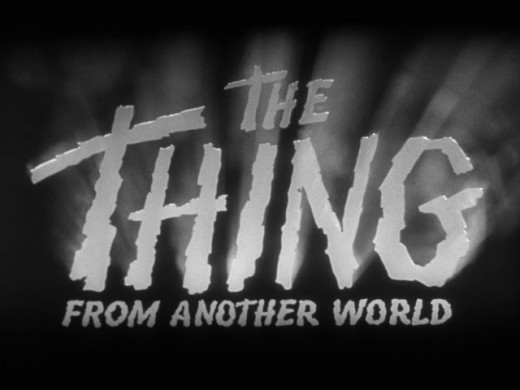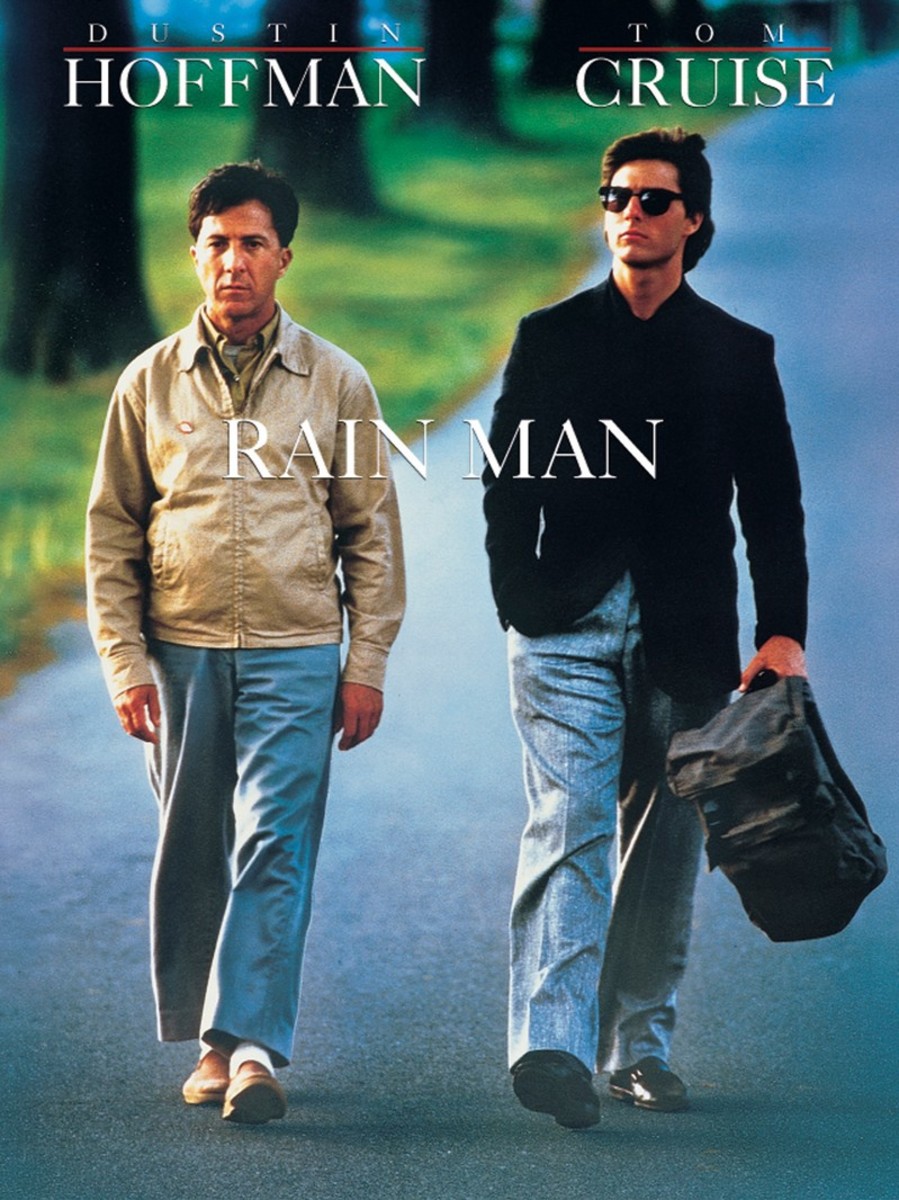The Thing From Another World (1951) - Film Analysis

A Conveyed American Fear of Early 1950‘s that Resonated With Audiences Throughout The Cold War
The film opens with the words “The Thing” melting or burning their way through the blackness of the screen. After the credits, the scene opens in a military officer’s club where a close-knit group of soldiers accompanied by a newspaper reporter is sent to check on a scientific encampment on the North Pole. Upon arriving, the crew is alerted to a strange aircraft crash in the area, and upon traveling to the site, the soldiers and scientists find flying saucer and its alien pilot encased in the arctic ice. While the ship is destroyed in an attempt to melt the ice, the creature is extracted and flown, alien pilot encased in a large block of ice, back to the camp. While the military and scientific groups argue about whether or not to remove the body from the ice block, the creature is inadvertently thawed and escapes. The film continues with a progressively tense cat-and-mouse game between the creature and the humans. Unable to escape or make contact with the outside world because of inclement weather. the group bickers about how to handle the situation. The soldiers set about trying to capture and destroy the alien creature, the scientists insist it should be studied and communicated with. Eventually, we learn that the creature is some kind of vegetable, an “intellectual carrot”, who lives on blood and is seeking to plant its seed. The scientists even speculate that it is emotionless, driven only by intellect and rationality, and is bent on conquering the planet with an army of similar plant things. While the cold does not affect the plant, the group reasons that it can be burned, and after trying to burn the Thing with kerosene, they devise a plan to use electricity. A trap is laid, and the group lures the creature to the appointed spot where it is burned by an electrical arc until nothing is left. The humans are left to care for the wounded and alert the world to “Keep watching the skies!”
Arguably, WWII didn’t end in 1945 but merely changed enemies. Fascism had been the first enemy, and communism the second. With the introduction of atomic weapons, this was an enemy that could not be engaged directly but rather, through a series of indirect clashes. The Cold War began almost immediately after the defeat of the Axis powers. By 1949, the Soviet Union had exploded its own atomic bomb, and both countries were soon pushing to develop more powerful weapons such as the hydrogen bomb. Then in 1950, the first of the Cold War skirmishes began as U.S. forces involved themselves in the Korean War. The undeclared war in Korea lasted only three years but would be America’s fourth bloodiest war with more than 50,000 American casualties. Perhaps unable to sustain the unified effort of WWII, even in the face of a potentially greater threat, Americans effectively turned the problem over to a technically sophisticated and increasingly professional military, thus maintaining a combat and military ready disposition of the country. Behind the paranoia about infiltrating communist spies and the on again off again military clashes, lay the most enduring of 1950’s anxieties: The atomic bomb. On the one hand, Americans considered it the greatest scientific invention of the century. On the other hand, the deadly possibilities of the bomb became more inherent. The advancement of these weapons made the metaphorical “doomsday clock” all the more literal. Fear was in the air. By the 1950s, America’s economy was largely organized by the principles of “Fordism”. Derived from the assembly-line logic of Henry Ford, the system of Fordism expanded to encompass the relationship between corporations, labor, governments, and eventually, the broader culture. But while Fordism proved effective in revitalizing American’s postwar economy, it carried with it a number of questionable cultural tendencies. First, Fordism relied heavily on a group of experts, preferring the opinions of experts to the deliberation of the average citizen. Second, corporate and governmental systems were organized through a kind of cold, scientific rationality as opposed to traditional or sentimental principles. The underlying principle of cultural development became progress. Underlying the emphasis on progress was a belief in efficiency as chief cultural goal. This version of efficiency, however, came into conflict with the traditional American value of individualism. Fordism insisted that individuals subjugate themselves to processes dictated by experts. Each member of the organization essentially functioned as a disconnected, unthinking gear in an increasingly distant and complicated machine. The interconnection between a culture of expertise, the rise of scientific rationality, and the emphasis on efficiency made the American worker both increasingly productive and increasingly alienated. Americans were, in essence, guaranteed the security necessary for personal liberty only on the condition that they conform to the will of the expert authorities.
At the core of the film is the bond of camaraderie among members of “The Americans.” It is this core group that must face the challenge of the threatening other and overcome it without falling into conflict amongst themselves. The group becomes a metaphor for the American dream, a nation capable of facing the challenge of the unknown and facing its own diversity and division, not through strength or knowledge alone but through abiding affection that bonds it together. As a viewer, we enter the film with the newspaper reporter Scotty, and in the officer’s club of the facility we encounter the members of the core group for the first time, enjoying a poker game. Our initial encounter with Captain Hendry provides an interesting example of the heroic figure. He is clearly above the other members, his rank an bearing indicate it, but he is not above the group or even removed from it. The other group members, Lieutenant Eddie and the navigator, McPherson, joke about the captain’s romantic misadventures, and all three engage in a kind of playful back and forth. After a discussion of a past meeting between Scotty and Eddie, the group quickly accepts the newspaper reporter. Scotty helps the crew chop the frozen alien out of the ice, and he assists with bringing supplies in from the plane. On two occasions, as the danger becomes intense, Hendry orders Scotty to “get back with the rest,” but on both occasions Scotty is allowed to stay for he is now part of the core group that must overcome the threat of the Thing. The group is both tight-knit and open to new members, but it also embodies a unique blend of professionalism and independence. On a number of occasions, the members of the group cease their banter and play and almost instantly fall into their professional role of soldiers. The follow “standard operating procedure” for removing the saucer from ice with thermite bombs with all the speed and efficiency of a well-oiled, “Fordism” machine. They quickly assemble to pursue the creature as it races off into the frozen night. They fight the creature with well-trained and professional precision and quickly move to care for their own once the skirmishes are over. The professionalism, however, is not a blind obedience to the rules and regulations of standard operating procedure or to hierarchy. The group openly ridicules Army regulations and eventually chooses to disobey direct orders from their superiors regarding the Thing. The same disregard for regulations and hierarchy is evident within the group itself. On a number of occasions, the members of the group suggest alternatives to Captain Hendry’s orders, and their suggestions are quickly taken up. For example, after setting guard duty at four-hour intervals, Captain Hendry is approached by Bob, who observes that the current guard is “having kittens” from being in such close confinement with the frozen alien. Bob suggest they change the rotation intervals to two hours, and the captain agrees. The synergy of the group is based largely on bonds of mutual respect and affection. Even the cinematography indicates their closeness. The film is filled with tight shots, focusing on the men in close proximity to each other, for example, sitting in the plane’s cockpit or making their way into the encampment for the first time. They share inside jokes, they care for each other, and they bond together in the face of adversity.
There are three prominent others the group encounters: Nikki, the scientists, and the Thing. These three others exist along a continuum of acceptance in which Nikki is sought out by the group, the scientists are accepted by largely not incorporated, and the Thing must be destroyed entirely. Nikki is not the kind of female heroine typical of the period. We learn that her previous date with Captain Hendry she out drank him and left him passed out on a bed with a note that his “legs aren’t very pretty.” In their onscreen courtship, she ties his hands behind his back and pours him drinks. Nikki is the one who pulls in for the kiss, and while Hendry pulls the same move after being untied, there is a kind of gender reversal game being played out between the two. A more ambivalent relationship exists between the group and the scientists, the groups of researchers led by Dr. Carrington who insist on researching the alien rather than destroying it. Carrington leads ands represents the scientists, and from his first appearance on screen he is marked as odd. His cloths, his facial hair, and demeanor suggest a snobbish intellectualism and, possibly, a disregard for humanity. It is Carrington who asserts the superiority of science in dealing with the problem of the Thing. It is clear from very early on in the film that the soldiers and the scientists will be in conflict. Carrington openly questions Hendry’s authority, and effectively establishes a second hierarchy of command. Carrington also develops a conflict with Scotty, bristling under reporter’s questions. When the conflict comes to a peak, the scientists seek higher authorities, relying on the military officials in Alaska to counter Captain Hendry and his men. As we watch the interactions among the scientists it becomes clear that they are held together by authority and expertise, not by affections and respect. The degree to which the scientists disregard human sentiment is made most apparent by the admiration Dr. Carrington describes the Thing by stating, “On the planet from which our visitor came vegetable life underwent an evolution similar to our own animal life, which would account for the superiority of its brain. Its development was not handicapped by emotional or sexual factors. Upon discovering the creature’s seedpod, he adds, “The neat and unconfused reproductive technique of vegetation. No pain or pleasure as we know it. No emotion, no heart. Our superior. Our superior in every way. Gentleman, do you realize what we’ve found? A being from another world as different from us as one pole from the other.” The Thing, in other words, resembles the inhuman and unsentimental American stereotype of the soviets. The Thing seeks to spread its “seed” and create a “horrible army” and conquer the planet. We see it tearing away at the camp’s dogs. We hear of how it slaughters some of the scientists. A tall, lumbering creature with no desire for peace. Like the American view of the Soviets, the Thing is driven not by passion passion or sentiment, but by the desire to conquer and regulate human life based solely on rationality and expertise.
“Keep watching the skies.” With these last lines we see that only “the Americans” are unable, and unwilling, to embrace the Thing. Where the Americans are based on affiliation and respect, the alien evidences no such capacity for the warmth of human affection. As such, the creature is destroyed. Although the film leaves open the possibility that this is only the first of many encounters to come, it is clear that we can take some comfort in the camaraderie amongst our fellow American is the coming dark years of the Cold war.







